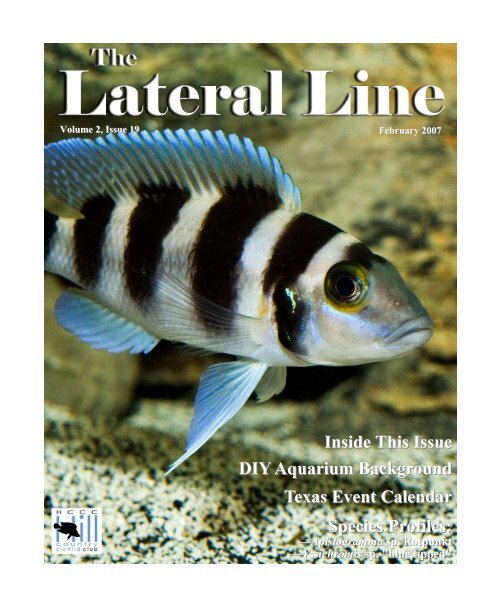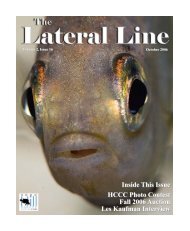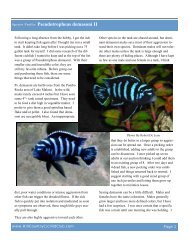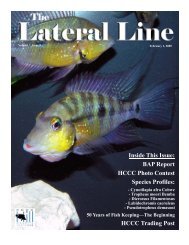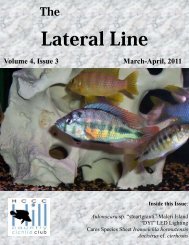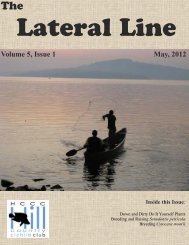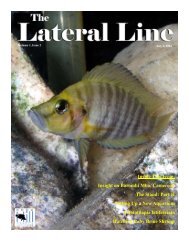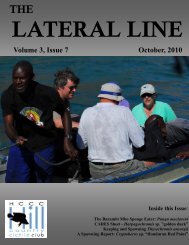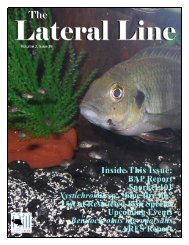Lateral Line February 2007.pub - Hill Country Cichlid Club
Lateral Line February 2007.pub - Hill Country Cichlid Club
Lateral Line February 2007.pub - Hill Country Cichlid Club
You also want an ePaper? Increase the reach of your titles
YUMPU automatically turns print PDFs into web optimized ePapers that Google loves.
Volume 2, Issue 19 <strong>February</strong> 2007<br />
Inside This Issue<br />
DIY Aquarium Background<br />
Texas Event Calendar<br />
Species Profiles:<br />
—Apistogramma<br />
sp. Rotpunkt<br />
—Yssichromis<br />
sp. "blue tipped"
The <strong>Lateral</strong> <strong>Line</strong> Page 2<br />
BAP Report<br />
January was a cold month for us South Texas Natives and even<br />
though there were few BAP reports, they all carried achievements<br />
with them.<br />
<strong>February</strong> 15, 2007<br />
INSIDE THIS<br />
ISSUE:<br />
Apisto. sp. Rotpunkt 3<br />
DIY Background 5<br />
Yssichromis sp. “blue tip” 8<br />
Duc's (Bassic) entry of Neetroplus nematopus was a 1st of species<br />
spawn. The total points (205) with this spawn entitled him the<br />
"Advanced Breeder" award. Congratulations Duc on both the 1st of<br />
species and "AB" award.<br />
Robert (Ripple) entry of "Christmas Fulu" came at an appropriate<br />
time of the year. The Xystichromis phytophagus common name indicates<br />
the brilliant colors of this fish during breeding. Not only a<br />
pretty fish but is listed on the "Endangered Species". Congratulations<br />
Robert on your entry and for contributing to the welfare of future<br />
generations of this species.<br />
Congratulations to Greg (Mokkers) who advanced to the "Breeders<br />
Award" level for breeding 5 different species. Greg now has 7 entries<br />
which total 120 point moving him closer to next level. Congratulations<br />
Greg, keep up the good work.<br />
Another member reached a new level in the BAP with his 5th entry<br />
that entitles him to the "Breeder Award". Congratulations to Eric<br />
(EAKF) on this achievement and continued success with your fish in<br />
the future.<br />
Cover Photo:<br />
Neolamprologus<br />
tretocephalus<br />
By Dave Hansen<br />
Because I was excited for David (Dockusan) accomplishment of<br />
Breeder of the Year for 2006, I overlooked another accomplishment<br />
of his. His last report for 2006 placed him over the 400 point level<br />
which entitles him to HCCC Accomplished Breeder Award. Congratulations<br />
on this achievement Doc and keep them coming.<br />
■ Jim Beck
The <strong>Lateral</strong> <strong>Line</strong> Page 3<br />
Species Profile:<br />
Apistogramma sp. Rotpunkt<br />
Apistogramma sp. Rotpunkt is a substrate<br />
spawner native to the Rio Orinoco valley,<br />
Venezuela. The climate is sub-tropical with<br />
temperatures in the mid 70's to 80's and native<br />
waters for this fish are pH of 6. I obtained six<br />
1/2 inch long fish from a fellow hobbyist last<br />
year. Males achieve a size of 3 inches and are<br />
pale yellow to gold with powder blue markings<br />
around the jaw and a black horizontal stripe<br />
laterally equidistant. Females achieve a size of<br />
2 inches and are pale yellow to electric yellow<br />
with black vertical barring especially when<br />
agitated. They also have an exaggerated black<br />
stripe on the leading of the pectoral fins. Males<br />
have this as well, but they have long trailing<br />
edges that are a light peach tone.<br />
The fish bred for me in a 15-gallon tank, which<br />
contained medium blasting media and was<br />
planted with java fern and somewhat of an algae<br />
mat. The tank was filtered by an Aquaclear<br />
hang on back filter running with one sponge<br />
and one sock full of peat moss pebbles made by<br />
Fluval. I performed weekly water changes<br />
roughly 40% of the tank volume. I used fluorescent<br />
lighting for a duration of 14 hours each<br />
day. I fed the fish flake food as a staple with<br />
supplements of bloodworms, blackworms, and<br />
brine shrimp.<br />
When spawning, the blue color of the male<br />
intensifies and he wants to display his plumage.<br />
The females change to a bright yellow and the<br />
black vertical bar markings fade a bit. They<br />
seem to breed in caves. I've spawned them in<br />
PVC elbows buried in the gravel, and I have<br />
several inverted clay pots with 3/4" holes<br />
drilled in the side. After low pressure systems<br />
move through, cold water (several degrees up<br />
to 15 or so), preferably rainwater should be<br />
added to the tank to attempt to induce spawning.<br />
You're trying to simulate a flood in the<br />
river, so I usually feed worms or other high<br />
protein items for a few days prior at the minimum,<br />
and then perform a water change with<br />
the colder water.<br />
The pair laid approximately 25 or so eggs.<br />
After spawning, the female retreated to a hiding<br />
place for the fry (her clay pot). She ferociously<br />
attacks anyone who dares come near<br />
save for the male she spawned with, and even<br />
then she is wary. She is quite the doting<br />
mother taking the kids on "walks" about the<br />
tank and herding them back to the safety of<br />
the cave. Due to her ferocity, this is when I<br />
believe the female aggression issues come<br />
about. After a while the fry get to be big<br />
enough no one else in the tank will eat them<br />
and the survivors are left alone. They tend to<br />
be quite boisterous at the front of the tank<br />
prior to reaching maturity. I actually left the<br />
tank alone and let the mom take care of the<br />
kids, and had 10 or so from each spawning.<br />
The fry were a yellow-tan in color and about 5<br />
millimeters long and looked like a pair of eyeballs<br />
with a tail for the first week or so.<br />
The fry didn't require any special care on my<br />
part. I left them in the 20 gallon tank with the
The <strong>Lateral</strong> <strong>Line</strong> Page 4<br />
parents and they did great, with minimal losses.<br />
Once the female released the fry from her care,<br />
she did not exhibit any tendency to exhibit any<br />
favoritism toward the fry. I started the fry off<br />
on crushed flake and ground freeze-dried<br />
bloodworms. The fry grew moderately, and<br />
now 4-5 months later they are ¾ of an inch<br />
long now, and starting to color up.<br />
These fish are very active prior to spawning.<br />
They tend to just frolic about the tank freely.<br />
Once the spawning begins however, the females<br />
turn a canary yellow, and take on a<br />
highly defensive status around their home of<br />
choice. These fish breed in a harem-polygynous<br />
manner, which consists of several females locating<br />
small caves to reside in with the dominant<br />
male protecting the territory, actively driving<br />
away intruders.<br />
I really enjoyed keeping these fish. They provide<br />
a lot of spunk in a small easy to keep size,<br />
and have very interesting habits, especially as<br />
parents. For their reputation as being difficult to<br />
keep I found quite the opposite to be true. I<br />
would definitely recommend this species to<br />
other fish keepers looking for an interesting<br />
group of fish while staying in a size constraint,<br />
Dave’s Rare Aquarium Fish<br />
a proud supporter of the HCCC<br />
5121 Crestway Drive Suite 300<br />
San Antonio, TX 78239 (210) 599-9444<br />
Member discounts<br />
www.DavesFish.com<br />
but I wouldn't hesitate to put them in a larger<br />
tank in order to see the expanse of territory<br />
they will command if allowed to. While it's<br />
probably not best suited to the beginner, it<br />
would be an excellent choice for an intermediate<br />
level hobbyist.<br />
Be prepared to deal with very aggressive females<br />
at spawning time and offer lots of cover<br />
both at the bottom and top of the tank. In the<br />
wild these fish are found in leaf litter and debris<br />
and seem to enjoy it in the aquarium as<br />
well. I also found that they are not too picky<br />
about the water quality with regard to nitrates.<br />
I actually think most fish thrive more on consistency,<br />
then quality, and that the stability<br />
thru neglect of the tank conditions can actually<br />
provide a suitable condition for spawning<br />
if they are well fed and the pressure drops.<br />
Due to their habitat in leaf debris and plant<br />
leaves, these are probably not the best choice<br />
for someone who desires pristine clear water<br />
looking tank. My dominant female beat up<br />
both males and females on a regular basis, and<br />
even killed off a couple of males that were<br />
several times bigger than she is on several<br />
occasions, so be prepared to deal with a death<br />
or two. Remember this is still part of the life<br />
cycle. The rotpunkts will give you lots<br />
of ups and downs like a roller coaster, as<br />
they breed, and entertain family life, and<br />
then have squabbles that can end in the<br />
sudden death of a beloved family member.<br />
All in all this is a most interesting<br />
species worthy of keeping.<br />
■ Eric Foreman
The <strong>Lateral</strong> <strong>Line</strong> Page 5<br />
DIY Article:<br />
Aquarium Background<br />
The supplies you'll need are styrofoam, knives,<br />
a blow dryer or heat gun, Quikrete Mason Mix<br />
Cement, Quikrete Concrete Acrylic Fortifier,<br />
cheap 2" paint brush, 100% silicone caulking,<br />
and Concrete paint (optional).<br />
The first step is to cut the styrofoam to the size<br />
that will cover the back of the aquarium. I put<br />
tape down on the garage floor to the dimensions<br />
of the tank so I could set up the background<br />
there. Plan for the styrofoam to be in 3<br />
pieces. If you don't, the complete structure<br />
won't fit into the aquarium (for larger aquariums)<br />
because of the cross bar in the middle. It<br />
helps if you cut these 3 pieces in a puzzle-like<br />
fashion so they'll lock together in the tank.<br />
They can be cemented together at that time<br />
with the 100% silicone caulking.<br />
River City Aquatics<br />
a proud supporter of the HCCC<br />
Member discounts:<br />
20% off livestock<br />
10% off dry goods / 10% off aquariums<br />
12108 Roxie Dr., Suite D<br />
Austin, TX (512)219-7200<br />
Next, using silicone caulking, glue smaller,<br />
miscellaneous pieces of styrofoam onto the<br />
larger pieces so that you have 3 large sheets<br />
with 1-2 layers of smaller pieces on top. Next,<br />
you'll need to cut holes in the styrofoam in<br />
order to make it appear like a rock formation.<br />
You could even create some caves and tunnels<br />
if you wish (this is where a smaller knife<br />
comes in handy). I used an electric<br />
kitchen knife to cut the styrofoam pieces<br />
to size and desired shape. Make sure you<br />
allow places for filtration and other tank<br />
accessories when designing your background.<br />
Once you have your basic shape cut and<br />
crafted, you can heat the surface using<br />
either the heat gun or blow dryer in order
The <strong>Lateral</strong> <strong>Line</strong> Page 6<br />
to smooth out the styrofoam's sharp corners.<br />
The knifes can also be used for this while cutting<br />
the styrofoam pieces to size. This and all<br />
subsequent steps should be done outside or in<br />
another suitable, well-ventilated area.<br />
development of the rocky look. Mix the cement<br />
following the mixing instructions on the<br />
cement bag, and then add some more cement<br />
powder until the cement will hold it's shape.<br />
Then, using<br />
your hands,<br />
apply the cement<br />
all over<br />
your background<br />
until it<br />
has your desired<br />
shape<br />
Once complete,<br />
allow this layer<br />
to cure for at least 48 hours.<br />
Once you are happy with the three individual<br />
styrofoam pieces, it's time for the cement. I<br />
cemented my three styrofoam pieces outside of<br />
the fish tank completely. You could install your<br />
styrofoam now and do the following steps with<br />
the tank laying on it's back. I followed the instructions<br />
for mixing on the cement bag, but<br />
then added the Acrylic Fortifier per the directions,<br />
and then added additional water until the<br />
cement was very runny. I applied this layer<br />
using the paint brush to ensure a complete<br />
layer over the styrofoam. This layer's function<br />
is to bond with the styrofoam and provide<br />
a surface for the remaining cement to<br />
bond to. Coat each of the three large pieces<br />
and then allow it to cure for at least 24<br />
hours before continuing. I coated the back<br />
surface of my background with this layer,<br />
but it is not necessary.<br />
The final layer provides the finishing touches.<br />
Amazonia International<br />
a proud supporter of the HCCC<br />
Member discounts:<br />
20% off Fish & Live Plants<br />
10% off Tanks, Stands, Eheims & Eclipses<br />
25% off Filters & Powerheads<br />
The second layer is where you will get the<br />
bulk of your cement forming and further<br />
4631 Airport #116 Austin, TX<br />
(512) 451-0958
The <strong>Lateral</strong> <strong>Line</strong> Page 7<br />
If you want to add concrete paint, this is the<br />
time to do it. Mix the cement so it is runny and<br />
can be applied with a paint brush. Then, coat<br />
the entire background with this layer. While<br />
doing this, you need to decide if you want a<br />
smooth look, or a rough texture. You may need<br />
to adjust the mixture in order to get the right<br />
look. I went with the<br />
rough texture, so I left<br />
my final coat runny, and<br />
applied it with a brush<br />
over the rougher second<br />
layer. If you wanted a<br />
smoother texture, you<br />
would need to make it a<br />
little less runny, and apply<br />
it with hands or<br />
brush to get the right<br />
look, filling in the gaps<br />
on the second layer. Once complete, allow this<br />
layer to cure for at least 48 hours.<br />
Follow these next guidelines regardless of<br />
when you're putting the background into the<br />
tank. You need to coat the back of the styrofoam<br />
heavily with the silicon. Use it all up. The<br />
buoyancy of the styrofoam needs a lot of silicon<br />
to hold it down. Obviously, add one piece<br />
at a time, apply the silicon right before putting<br />
the piece in the tank. It helps to set the pieces<br />
up outside of the tank to make sure you have<br />
everything right. Once all pieces are in the<br />
tank, you need to allow at least 24 hours for the<br />
silicon to cure. To be safe, wait the time specified<br />
for a total cure on the silicon itself. It must<br />
be totally cured before adding water, otherwise<br />
the silicon may give way.<br />
Once you've added water, setup a pump to<br />
circulate the water. Check the pH after the<br />
first day, it should be elevated. Perform 50%<br />
water changes every 2 days or so for at least 2<br />
weeks. If the pH was elevated, wait until it is<br />
consistently back at your normal level. In my<br />
opinion, it's better to be safe. My tank actually<br />
had water in it for a month before I added my<br />
first fish.<br />
At this point, your tank is ready to go! Your<br />
fish will enjoy the caves and other features<br />
you've added for them.<br />
■ Paul Barber<br />
AquaTek Tropical Fish<br />
a proud supporter of the HCCC<br />
10% off Fish<br />
8023 Burnet Rd. # 1<br />
Austin, TX 78132<br />
(512) 450-0182
The <strong>Lateral</strong> <strong>Line</strong> Page 8<br />
Species Profile:<br />
Yssichromis sp. "blue tipped"<br />
The genus name Yssichromis is Greek based in<br />
"yssos" meaning javelin or arrow correlating to<br />
the elongated slender body shape exhibited by<br />
these cichlids. These are usually smaller fish<br />
with pointed (arrow shaped) heads with a low<br />
straight or slightly convex cranial slope. The<br />
outer rows of both jaws are made up of unequally<br />
bicuspid teeth foremost, and tricuspid<br />
towards the rear. Small tricuspid teeth make up<br />
the inner rows. The lower jaw extends beyond<br />
the upper similar to Prognathochromis<br />
(Tridontochromis) species. The premaxillary is<br />
not as obvious as the fore mentioned species.<br />
The eyes of Yssichromis species are comparatively<br />
larger than most other Haplochromines.<br />
Most Yssichromis are considered zooplanktivores.<br />
Until the late 70's this representatives<br />
from the genus were abundant in many portions<br />
of Lake Victoria. With the up serge of Lates<br />
niloticus in the 1980's, Yssichromis numbers<br />
dropped off dramatically. In the early 1990's,<br />
various Yssichromis species began to appear<br />
once again in samplings. Numbers of some<br />
species (Y. laprogramma) were more abundant<br />
in the mid 90's than initial estimates in<br />
the 70's (Goldschmidt 1990, Seehausen 1997).<br />
Usually thought of as an open water schooling<br />
fish (comparative to the Cyprichromis species<br />
of Lake Tanganyika) some Yssichromis found<br />
refuge from the Nile perch by blending in<br />
with large schools of cyprinid (Rastrineobola<br />
argentea).<br />
Yssichromis sp. "blue tipped" was discovered<br />
in 1992 by Yves Fermon and Olivier<br />
Berthelot off Rusinga Island Lake Victoria.<br />
This schooling species feeds upon zooplankton<br />
and will also take small insects in the<br />
wild. Maximum size is near 10cm for males,<br />
slightly smaller for females. The body shape<br />
is slender and elongated with a straight cranial<br />
slope. The lower jaw extends slightly beyond<br />
the upper. Subdominant males have a dull<br />
red-purple back with a lighter tan colored line<br />
directly under the dorsal fin. The flanks are<br />
light lime-green with dotted with dark blotching<br />
along the mid body. The blotches run<br />
along, and are part of very faint vertical bar-<br />
Darby’s Tropicals<br />
a proud supporter of the HCCC<br />
10% off Livestock & Plants<br />
5514 IH 35 South<br />
New Braunfels, TX 78132<br />
(830) 625-1122
The <strong>Lateral</strong> <strong>Line</strong> Page 9<br />
ring. The abdomen is light brown. Two dark<br />
blotches on the caudal region are joined by a<br />
thin black bar running between them. The caudal<br />
fin is translucent. The dorsal has a light<br />
blue coloration. This is where the descriptive<br />
name was derived. The anal fin is also clear<br />
with two well defined egg spots dotting the<br />
upper rear portion. Females are mostly silver<br />
in color. They have the same black blotching<br />
mid laterally that is found in males. These<br />
blotches run into each other forming an almost<br />
continuous solid line. The pelvic, anal and<br />
caudal fins have a yellow tinge to them. Some<br />
blue can be seen on the forward portion of the<br />
dorsal. Dominant males sport jet-black body<br />
coloration. This black is so intense that when<br />
reflected by light, a green sheen appears. The<br />
dorsal fin is metallic-blue frontally and the<br />
remaining portion black. There is a yellow<br />
edging to this fin. The caudal fin is black with<br />
yellow edging. The yellow coloration is<br />
thicker at both points on the fin than between<br />
them. The anal fin is black at the base with<br />
lighter colored rays. The outer portions are<br />
yellow. The (usually) two orange ocelli are<br />
surrounded by a solid black orbit. The pelvic<br />
fins are black with the first ray elongated.<br />
Being an open water species, we house our<br />
group in a 65 gallon deep tank with a silica<br />
sand substrate. One side of this tank contains<br />
a small rock work structure. A few strands of<br />
artificial Vallisneria are situated in the middle<br />
of the tank. Filtration is provided by an<br />
Aquaclear® 300 hang on the back power filter.<br />
Weekly water changes of twenty gallons<br />
help maintain acceptable conditions. The<br />
Yssichromis sp. "blue tipped" are housed with<br />
a colony of Platytaeniodus sp. "blue neon" of<br />
similar size. This mixture works well as both<br />
species are distinct enough that hybridization<br />
is unlikely. The rock structure is used by the<br />
Platytaeniodus sp. "blue neon" as a territorial<br />
boundary but has little attraction to the Yssichromis<br />
sp/ "blue tipped". Neither species is<br />
overly aggressive with the other; squabbles<br />
are restricted to co specs. The Platyaeniodus<br />
sp. "blue neon" prefer to remain near the bottom<br />
while the Yssichromis sp. "blue tipped"<br />
are usually roaming the upper portion of the<br />
aquaria. There are occasional bluffing duels<br />
between the most dominant males of each<br />
species but these are no more than jetting forward<br />
in an attempt to back the other up.<br />
There is no physical contact or jaw locking<br />
that occurs.<br />
As male coloration darkens, one can be certain<br />
that spawning activity is already in the<br />
works. In our colony, two males suddenly<br />
turned jet-black with intense yellow edging to<br />
the fins. The next two days were spent bluffing<br />
one another with jetting runs at one an-
The <strong>Lateral</strong> <strong>Line</strong> Page 10<br />
other. Both males were of equal size and neither<br />
gave in. Each maintained dominant coloration<br />
and began courting an obviously ripe<br />
female. As of yet I have been unable to witness<br />
an actual spawning but have observed the<br />
pre-spawning dance on multiple occasions.<br />
The spawning advances occur in mid strata.<br />
The female roamed from one side of the tank to<br />
the other enticing each male to shake wildly<br />
presumably provoking her into mating. After<br />
two days, one of the males had obviously succeeded<br />
in winning the female over as she had a<br />
definite extended buccal cavity. The female is<br />
not harassed at all while incubating her young.<br />
We waited for 14 days and stripped her. She<br />
had 12 nearly free swimming fry. The young<br />
were placed in an egg tumbler for two days<br />
while the remaining egg sac was absorbed.<br />
The free swimming young are now in a 20 gallon<br />
tank where they are growing rapidly on a<br />
diet of Cyclop-eeze® and crushed basic flake.<br />
The fry are hardy and present no problems with<br />
regards to rearing. Filtration in the fry tank is<br />
provided by a sponge filter. Ideally, a five gallon<br />
water change should be done twice a week.<br />
I suspect that spawning occurs on the tank bottom.<br />
The first two occasions I had a female<br />
hold she was found to only be carrying small<br />
stones when stripped. It is probable that she<br />
had picked up these stones with her own eggs<br />
and through the process of tumbling them<br />
around her throat, they disintegrated over time.<br />
Once we changed the substrate to silica sand,<br />
this problem disappeared.<br />
Yssichromis sp. "blue tipped" ("tipped blue" as<br />
named by Fermon and Berthelot) is a very rare<br />
fish in the North American hobby. It is not<br />
held in the LVSSP program so it is up to the<br />
hobbyist to ensure its survival. Wild populations<br />
figures are unknown but like the others<br />
members of the genus, it should be considered<br />
at risk.<br />
■ Greg Steeves<br />
References:<br />
Witte, F. B. S. Msuku, J. H. Wanick, O. Seehausen, E. F.<br />
B. Katunzi, P. C. Goudswaard, & T. Goldschmidt. Recovery<br />
of <strong>Cichlid</strong> Species in Lake Victoria: An Examination<br />
of Factors Leading to Differential Extinction. Reviews<br />
in Fish Biology and Fisheries 10; p 233-241.<br />
Khower Academic Publishers, 2000.<br />
Greenwood, P. H. A revision of the Haplochromis and<br />
related Species (Pisces, <strong>Cichlid</strong>ae) from Lake George,<br />
Uganda. Bulliten of the British Muesem of Natural History<br />
25. p 139-242 (1973: 27th June).<br />
Greenwood, P. H. & J. M. Gee; 1969; "A Revision of the<br />
Lake Victoria Haplochromis species (Pisces, <strong>Cichlid</strong>ae),<br />
part VII"; Bulletin of the British Museum (Natural History)<br />
Zoology Series; v. 18, n. 1, pp. 1-65.<br />
Katunzi, E. F. B. J. Zoutendijk, T. Goldschmidt, J. H.<br />
Wanink, F. Witte. Lost Zooplanktivorous <strong>Cichlid</strong> from<br />
Lake Victoria Reappears With a New Trade. Ecology of<br />
Freshwater Fish 2003: 12: 237-240.
The <strong>Lateral</strong> <strong>Line</strong> Page 11<br />
Event Calendar:<br />
Upcoming Events in Texas<br />
All of the information has been obtained from<br />
other club’s websites. Dates and times have<br />
not been confirmed. Please check with each<br />
clubs if you plan to attend any of their events.<br />
This list may not be complete so don’t assume<br />
every event is included here.<br />
<strong>February</strong>:<br />
<strong>February</strong> 17th<br />
Time: 7 P.M.<br />
Texas <strong>Cichlid</strong> Association—Regular monthly<br />
at the Clarion Hotel DFW South in Irving.<br />
March:<br />
<strong>Hill</strong> <strong>Country</strong> <strong>Cichlid</strong> <strong>Club</strong>—Date, Time and<br />
Location TBD.<br />
March 17th<br />
Time: 7 P.M.<br />
Texas <strong>Cichlid</strong> Association—Regular Monthly<br />
Meeting at the home of David Andrews, 3828<br />
Wayland Drive, Fort Worth. Phone: (817)<br />
291-4169<br />
March 18th<br />
Time: 11 A.M.<br />
Houston Aquarium Society—Spring Live<br />
Fish Auction. Doors open at 10 A.M. for sellers.<br />
American Legion Post, 11702 Galveston<br />
Rd., Houston.<br />
April:<br />
April 13th-15th<br />
Texas <strong>Cichlid</strong> Association—Spring Show<br />
and Workshop at the Clarion Hotel DFW<br />
South in Irving. Confirmed speakers to date<br />
include Ad Konings and Greg Steeves.<br />
April 15th<br />
Time: 2 P.M.<br />
<strong>Hill</strong> <strong>Country</strong> <strong>Cichlid</strong> <strong>Club</strong>—Monthly meeting<br />
at Jeff Johnson’s house. Details to follow.<br />
Lisa’s Lair Bookstore<br />
Online Books<br />
Various Discounts for<br />
HCCC Members<br />
www.lisaslairbookstore.com
The <strong>Lateral</strong> <strong>Line</strong><br />
Official Publication of the<br />
<strong>Hill</strong> <strong>Country</strong> <strong>Cichlid</strong> <strong>Club</strong>


